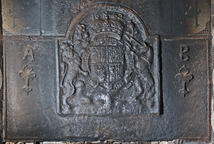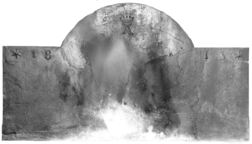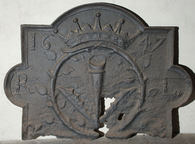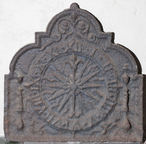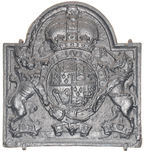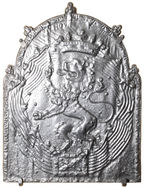-
1144
Description: Composite; arched rectangular shaped, armorial fireback, cavetto edging, with Stuart Royal arms, garter, supporters, crown and motto, and 1662 date above crown; this overlies a rectangular plate with fillet edging; top centre in the space each side of the central shield, an initial letter - A to left, B to right - each above a fleur-de-lys, its stem terminating in a small buckle.
Notes: Several firebacks have incorporated the same Stuart royal shield, which probably originally dated to 1619, but with the date altered. A similar fireback, but without the initials and fleurs-de-lys, dated 1661, and reputed to have come from the Totsey, the old guildhall at the market cross in Gloucester, is illustrated in Ames, 1980, 23; possibly the same fireback was reported by the late David Bick to be at The Grange, Minsterworth, Gloucestershire (demolished in the late 1960s).
Inscription: 16 62 / [Garter motto (illeg.)] / A B
Arms: English Stuart royal
- Decoration tags:
- rectangular with round arch (shape)
- fillet (edging)
- carved stamps
- carved pattern panels
- composite
- individual letters
- heraldic
- armorial
- royal
- text
Manufactured: in 1662 possibly in the Forest of Dean area of England.
Current location: in private hands, Norton, Wiltshire, England.
Citation: Ames, A., 1980, Collecting Cast Iron (Ashbourne, Moorland Publishing).
Citation: Badeni, J., 22 Sep 1983, 'Whose Fireback?' [letter], Country Life, 174, 4492, p. 772.
-
1141
Description: Arched rectangular shape; twisted rope edging (top and sides); date stamp, 1634, in arch; initials, EH, separated by a cross, below date.
Notes: The same date stamp has been noted on another fireback; the cross between the initials may have an apotropaic purpose.
Inscription: 1634 /E + H
- Decoration tags:
- rectangular with round arch (shape)
- rope (edging)
- simple stamps
- individual letters
- date stamp
- apotropaic
- text
- objects
Manufactured: in 1634 in England.
Current location: Newark Park, Ozleworth, Gloucestershire, England.
(part of the National Trust museum group)
- Attached to series:
- 1634 stamp series
-
1237
Description: Low-arched rectangular shape; cavetto-moulded edging (top and sides); top centre, shield, crest and motto of William Wood (1806-88), Bishop of Glasgow and Galloway.
Notes: The blazon: Per chevron Argent and Or, a chevron counter-embattled between three mullets gules; crest: a talbot's head erased Or; motto: Semper Vigilans - Always Vigilant.
Inscription: SEMPER VIGILANS
Arms: William Wilson, Bishop of Glasgow and Galloway
- Decoration tags:
- rectangular with round arch (shape)
- cavetto (edging)
- whole carved pattern
- heraldic
- armorial
- text
Manufactured: in the mid- to late-19th century in Scotland.
Current location: Norfolk Antique and Reclamation Centre, Woolseys Farm, Salhouse Road, Panxworth, Norfolk, England.
- Attached to series:
- Personal armorial firebacks
-
507
Description: Low arched rectangle with stepped shoulders; cavetto moulded edging; Stuart royal shield with lion and unicorn supporters, garter and crown.
Notes: The pattern was probably carved in high relief, but the depth of casting sand may have been insufficient for all the detail to be revealed. At least one horizontal plank line is visible.
Copies of this fireback are known.
Arms: English Stuart royal
- Decoration tags:
- rectangular with round arch (shape)
- rebated fillet (edging)
- whole carved pattern
- planklines
- armorial
- royal
Manufactured: in the late-17th to early-18th century in England.
Current location: Parham House, Parham, West Sussex, England.
- Attached to series:
- Stuart royal armorial firebacks
-
508
Description: Arched rectangular shape; no edging; top centre, crowned capital ‘A’; date divided at top corners of plate; single six-pointed star outside date.
Notes: Earl’s coronet denotes the Earl of Ashburnham, furnace owner; the furnace was blown out for the last time in late February 1813, this fireback being reputedly the last casting from a Wealden furnace. One of a small series of firebacks cast in the early-19th century for farms on the Ashburnham estate.
Inscription: * 18 A 13 *
- Decoration tags:
- rectangular with round arch (shape)
- none (edging)
- carved stamps
- individual letters
- individual numbers
- text
- objects
Manufactured: in 1813 at Ashburnham Furnace in the Weald area of England.
Current location: in private hands, Penhurst, East Sussex, England.
- Attached to series:
- Ashburnham late series
-
511
Description: Rectangular with semi-circular protrusions on the top and sides; cavetto edging; a pheon (a downward-pointing arrow head barbed on the inner edge), within a wreath, an earl’s coronet above; the date on either side of the coronet; the initials on left and right sides; a fleur de lys in each bottom corner.
Notes: The wreathed pheon and coronet are cast from a different pattern to the 1626 and 1630 plates.
Copies of this fireback are known.
Inscription: 16 47 / R L
- Decoration tags:
- rectangular with round arch (shape)
- cavetto (edging)
- whole carved pattern
- planklines
- heraldic
- text
Manufactured: in 1647 possibly at Robertsbridge Furnace, Salehurst in the Weald area of England.
Current location: Penshurst Place, Penshurst, Kent, England.
- Attached to series:
- Earl of Leicester series
- Personal firebacks
-
512
Description: Double arched rectangular shaped; ovolo edging; central clock dial with Roman numerals separated by stops, sunburst inside, single hand with fleur de lys pointer; teardrop weights, with finials above, suspended from each side; symmetrical tendrils above; date split below dial.
Notes: One of the ‘hooked 1’ series of firebacks; two versions exist of this fireback, the other without finials above the suspended weights.
Copies of this fireback are known.
Inscription: I · II · III · IIII · V · VI · VII · VIII · IX · X · XI · XII / 16 5 [..]
- Decoration tags:
- rectangular with round arch (shape)
- ovolo (edging)
- whole carved pattern
- pictorial
- text
- objects
Manufactured: in 1652 possibly at Brede Furnace in the Weald area of England.
Current location: Penshurst Place, Penshurst, Kent, England.
Citation: Gardner, J. S., 1898, 'Iron Casting in the Weald', Archaeologia, 56, 1, pp. 133-164.
- Attached to series:
- Hooked '1' series
- Brede group
-
558
Description: Arched rectangular shape; fillet edging; top centre, stamp formed of a carved domestic scene of a family around a table; in top corners, repeated small stamp of St George and the Dragon; below, repeated stamp of a pineapple in a pot; centre; small stamp of the royal arms of the United Kingdom 1801-37.
Notes: The domestic group has been formed from a decorative iron mantelpiece ornament portraying the tale of the goose that laid golden eggs. Having killed the goose, the family are lamenting the loss of their bounty (see Ames, 1980, p.94). The same mantelpiece group and pineapple stamp can be seen as decoration on the kitchen spit assemblage at Petworth House, West Sussex, which was cast at Robert Chorley's foundry at Cocking, south of Midhurst. Evidently this and another fireback bearing the same ornament stamp were among items from the Cowdray estate sold in 1898. Mitford collection, Petworth House.
Arms: Royal arms of the United Kingdom 1801-37
- Decoration tags:
- rectangular with round arch (shape)
- fillet (edging)
- carved stamps
- armorial
- royal
- animals
- humans
- plants
Manufactured: in the early-19th century probably at Cocking Foundry in the Weald area of England.
Current location: Petworth House, Petworth, West Sussex, England.
Museum number: NT/PET/M/50 (part of the National Trust museum group)
Citation: Ames, A., 1980, Collecting Cast Iron (Ashbourne, Moorland Publishing).
- Attached to series:
- Cocking foundry firebacks
- Ornament stamp firebacks
- Metalware stamp firebacks
-
563
Description: Arched rectangular shape; cavetto edging; Stuart royal arms of England (quarterly, 1st and 4th, France and England, 2nd Scotland and 3rd Ireland) with garter, crown, motto and supporters; initials either side of crown base.
Notes: As in others of this series the design overlaps the edging. Mitford collection, Petworth House.
Copies of this fireback are known.
Inscription: C R / ...SOIT QVI MAL Y ...
Arms: English Stuart royal
- Decoration tags:
- rectangular with round arch (shape)
- cavetto (edging)
- whole carved pattern
- armorial
- royal
- text
Manufactured: in the mid- to late-17th century in the Weald area of England.
Current location: Petworth House, Petworth, West Sussex, England.
Museum number: NT/PET/M/57 (part of the National Trust museum group)
- Attached to series:
- Small cavetto series
- Stuart royal armorial firebacks
-
580
Description: Arched rectangular shape with fillet edging and a repeated line and concentric semi-circle design; wicker enclosure with gate at bottom, overlaid with a lion rampant surmounted by a crown.
Notes: The enclosure is the Garden of Holland (Hollandse Tuin) and the lion the badge of the States General of the Netherlands; on the shoulders of the plate, and on three other positions equally spaced around the arch, repeated small fleurs-d-lys. Mitford collection, Petworth House.
Inscription: ...E HOV...
- Decoration tags:
- rectangular with round arch (shape)
- complex individual (edging)
- whole carved pattern
- heraldic
- text
- animals
- objects
Manufactured: in the mid- to late-17th century possibly in the Siegerland area of Germany.
Current location: Petworth House, Petworth, West Sussex, England.
Museum number: NT/PET/M/71 (part of the National Trust museum group)
- Attached to series:
- 'Dutch' Miscellaneous Firebacks
- 'Dutch' Garden of Holland firebacks
